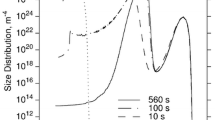Abstract
Computer aided materials design is of increasing interest because the conventional approach solely relying on experimentation is no longer viable within the constraint of available resources. Modeling of microstructure and mechanical properties during precipitation plays a critical role in understanding the behavior of materials and thus accelerating the development of materials. Nevertheless, an integrated computational tool coupling reliable thermodynamic calculation, kinetic simulation, and property prediction of multi-component systems for industrial applications is rarely available. In this regard, we are developing a software package, PanPrecipitation, under the framework of integrated computational materials engineering to simulate precipitation kinetics. It is seamlessly integrated with the thermodynamic calculation engine, PanEngine, to obtain accurate thermodynamic properties and atomic mobility data necessary for precipitation simulation.
Similar content being viewed by others
References
W. Cao et al., Calphad, 33(2) (2009), pp. 328–342.
W. Cao et al., “Precipitation Modeling of Multi-Component Alloys,” submitted to Acta Materialia (2011).
S.L. Chen et al., Calphad-Computer Coupling of Phase Diagrams and Thermochemistry, 26(2) (2002), pp. 175–188.
M. Avrami, The Journal of Chemical Physics, 7(12) (1939), pp. 1103–1112.
M. Avrami, The Journal of Chemical Physics, 8(2) (1940), pp. 212–224.
M. Avrami, The Journal of Chemical Physics, 9(2) (1941), pp. 177–184.
W.A. Johnson and R.F. Mehl, Trans. Am. Inst. Min. Metall. Eng., 135 (1939), pp. 416–458.
A.N. Kolmogorov, Izvestia Academy of Science, SSSR, Ser. Math, 3 (1937), pp. 355–360.
J.S. Langer and A.J. Schwartz, Physical Review A, 21(3) (1980), pp. 948–958.
R. Kampmann and R. Wagner, Decomposition of Alloys: The Early stages, ed. P. Haasen et al. (Oxford: Pergamon Press, 1984), pp. 91–103.
A. Deschamps and Y. Brechet, Acta Materialia, 47(1) (1998), pp. 293–305.
V. Gerold, Dislocations in Solids (Amsterdam: North Holland, 1979).
O.R. Myhr, Ø. Grong, and S.J. Andersen, Acta Materialia, 49(1) (2001), pp. 65–75.
J. Friedel, Dislocations (Oxford: Pergamon, 1964).
L. Kaufman and H. Bernstein, Computer Calculation of the Phase Diagrams with Special Reference to Refractory Materials (New York: Academic Press, 1970).
Y.A. Chang et al., Progress in Materials Science, 49(3–4) (2004), pp. 313–345.
Ø. Grong, Metallurgical Modelling of Welding, 2nd ed. (London: The Institute of Materials, 1997).
K.S. Wu et al., Superalloys 2008, ed. Roger Reed et al. (Warrendale, PA: TMS, 2008), pp. 923–940.
J.D. Robson, Materials Science and Technology, 20 (2004), pp. 441–448.
I.M. Lifshitz and V.V. Slyozov, J. Phys. Chem. Solids, 19 (1961), p. 35.
C. Wagner, Z. Elektrochem., 65 (1961), p. 581.
X. Xie et al., Superalloys 718, 625, 706 and Derivatives, ed. E.A. Loria (Warrendale, PA: TMS, 2005), pp. 193–202.
A. Baldan, J. Materials Science, 37 (2002), pp. 2171–2202.
C.K. Sudbrack, “Decomposition Behavior in Model Ni-Al-Cr-X Superalloys: Temporal Evolution and Compositional Pathways on a Nanoscale” (Ph.D Thesis, Department of Materials Science & Engineering. 2004, Northwestern University: Evanston, IL).
A. Oradei-Basile and J.F. Radavich, Superalloys 718, 625 and Various Derivatives, ed. E.A. Loria (Warrendale, PA: TMS, 1991), pp, 325–336.
W.F. Miao and D.E. Laughlin, Scripta Materialia, 40(7) (1999, pp. 873–878.
S.J. Andersen et al., Acta Materialia, 46(9) (1998), pp. 3283–3298.
W.A. Anderson, Precipitation from Solid Solution (Metals Park, OH: American Society for Metals, 1959).
J. Guo et al., “Prediction of Microstructure and Mechanical Properties in Aluminum Castings after Heat Treatment” (Paper presented at the TMS 2010 Annual Meeting & Exhibition, Seattle, WA, February 14–18, 2010).
Author information
Authors and Affiliations
Corresponding author
Rights and permissions
About this article
Cite this article
Cao, W., Zhang, F., Chen, S.L. et al. An integrated computational tool for precipitation simulation. JOM 63, 29–34 (2011). https://doi.org/10.1007/s11837-011-0106-2
Published:
Issue Date:
DOI: https://doi.org/10.1007/s11837-011-0106-2




